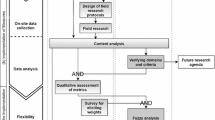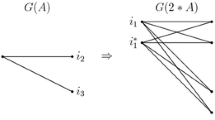Abstract
Effectiveness in humanitarian supply chain operations depends on the critical last mile between beneficiaries and needed supplies or services. Often, the last mile is traveled by the beneficiaries themselves. This paper’s focus is on systems in which beneficiaries make autonomous decisions about where to seek supplies or services using a utility function that captures distance, congestion, and the relative importance of the two factors. We model beneficiary behavior as a network congestion game where the resources are a set of facilities from which individuals choose. Importantly, our models capture the fact that the relative importance of distance and congestion may be specific to both the individual and the facility; we represent this using a factor called the congestion weight. We prove new bounds on the system performance that results from decentralized beneficiary decisions in comparison to centralized optimal assignments, and we introduce mechanisms for achieving centrally optimal outcomes even in the presence of decentralization. We demonstrate the methods with data from the international public health response to the Haiti cholera epidemic.








Similar content being viewed by others
References
Ackermann, H., Röglin, H., & Vöcking, B. (2008). On the impact of combinatorial structure on congestion games. Journal of the ACM, 55(6), 25:1–25:22.
Agrawal, R., & Ergun, Ö. (2008). Mechanism design for a multicommodity flow game in service network alliances. Operations Research Letters, 36, 520–542.
Ahuja, Ravindra K., Magnanti, Thomas L., & Orlin, James B. (1993). Network flows: Theory, algorithms, and applications. Upper Saddle River: Prentice-Hall Inc.
Awerbuch, B., Azar, Y., & Epstein, A. (2013). The price of routing unsplittable flow. SIAM Journal on Computing, 42, 633–644.
Balcik, B., & Beamon, B. (2008). Facility location in humanitarian relief. International Journal of Logistics: Research and Applications, 11(2), 101–121.
Balcik, B., Beamon, B. M., & Smilowitz, K. (2008). Last mile distribution in humanitarian relief. Journal of Intelligent Transportation Systems, 12(2), 51–63.
Bergendorff, P., Hearn, D. W., & Ramana, M. V. (1997). Congestion toll pricing of traffic networks. In P. M. Pardalos, D. W. Hearn, & W. W. Hager (Eds.), Network optimization lecture notes in economics and mathematical systems (Vol. 450, pp. 51–71). Berlin: Springer.
Burkhart, C., Nolz, P., & Gutjahr, W. (2017). Modelling beneficiaries’ choice in disaster relief logistics. Annals of Operations Research, 256(1), 41–61.
Christodoulou, G., & Koutsoupias, E. (2005). The price of anarchy of finite congestion games. Proceedings of the thirty-seventh annual ACM symposium on theory of computing, pp. 67–73.
Christodoulou, G., Koutsoupias, E., & Nanavati, A. (2004). Coordination mechanisms. In Díaz Josep, Karhumäki Juhani, Lepistö Arto, & Sannella Donald (Eds.), Lecture notes in computer science (Vol. 3142, pp. 345–357). Berlin: Springer.
Christodoulou, G., Mehlhorn, K., & Pyrga, E. (2011). Improving the price of anarchy for selfish routing via coordination mechanisms. In C. Demetrescu & M. M. Halldórsson (Eds.), Lecture notes in computer science (Vol. 6942, pp. 119–130). Berlin: Springer.
Fikar, C., Hirsch, P., & Nolz, P. (2018). Agent-based simulation optimization for dynamic disaster relief distribution. Central European Journal of Operations Research, 26(2), 423–442.
Gairing, M., & Schoppmann, F. (2007). Total latency in singleton congestion games. In X. Deng & F. C. Graham (Eds.), Lecture notes in computer science (Vol. 4858, pp. 381–387). Heidelberg: Springer.
Gairing, M., Monien, B., & Tiemann, K. (2011). Routing (Un-) splittable flow in games with player-specific affine latency functions. ACM Transactions on Algorithms, 7(3), 31:1–31:31.
Galindo, G., & Batta, R. (2013). Review of recent development in OR/MS research in disaster operations management. European Journal of Operational Research, 230(2), 201–211.
Guillaume, Y., Ternier, R., Vissieres, K., Casseus, A., Cherry, M., & Ivers, Louise. (2018). Responding to Cholera in Haiti: Implications for the national plan to eliminate Cholera by 2022. Journal of Infectious Diseases, 213(Supplement 3), S167–S170.
Haiti ministry of public health and population. (2011). Rapports journaliers du MSPP sur l’evolution du cholera en Haiti (Daily reports of MSPP on the evolution of cholera in Haiti). Available at http://www.mspp.gouv.ht/site/. Accessed July 10, 2017.
Heier Stamm, J. L. (2010). Design and analysis of humanitarian and public health logistics systems. Ph.D. thesis, Georgia Institute of Technology.
Heier Stamm, J. L., Serban, N., Swann, J., & Wortley, P. (2017). Quantifying and explaining accessibility with application to the 2009 H1N1 vaccination Campaign. Health Care Management Science, 20(1), 76–93.
Houghtalen, L., Ergun, Ö., & Sokol, J. (2011). Designing mechanisms for the management of carrier alliances. Transportation Science, 45(4), 465–482.
Ieong, S., McGrew, R., Nudelman, E., Shoham, Y., & Sun, Q. (2005). Fast and compact: A simple class of congestion games. Proceedings of the 20th national conference on artificial intelligence, vol. 2, pp. 489–494
Jahre, M., & Jensen, L. (2010). Coordination in humanitarian logistics through clusters. International Journal of Physical Distribution and Logistics Management, 40(8/9), 657–674.
Knight, A., & Harper, P. (2013). Selfish routing in public services. European Journal of Operational Research, 230(1), 122–132.
Kontogiannis, S., & Spirakis, P. (2005). Atomic selfish routing in networks: A survey. In X. Deng & Y. Ye (Eds.), Lecture notes in computer science (Vol. 3828, pp. 989–1002). Heidelberg: Springer.
Kothari, A., Suri, S., Tóth, C., & Zhou, Y. (2005). Congestion games, load balancing, and price of anarchy. In A. López-Ortiz & A. M. Hamel (Eds.), Lecture notes in computer science (Vol. 3405, pp. 13–27). Berlin: Springer.
Koutsoupias, E., & Papadimitriou, C. H. (1999). Worst-case equilibria. 16th annual Symposium on theoretical aspects of computer science. pp. 404–413.
Leiras, A., de Brito, I., Peres, E., Bertazzo, T., & Yoshizaki, H. (2014). Literature review of humanitarian logistics research: Trends and challenges. Journal of Humanitarian Logistics and Supply Chain Management, 4(1), 95–130.
Milchtaich, I. (1996). Congestion games with player-specific payoff functions. Games and Economic Behavior, 13(27), 111–124.
Muggy, L. (2015). Quantifying and mitigating decentralized decision making in humanitarian logistics systems. Ph.D. thesis, Kansas State University.
Muggy, L., & Heier Stamm, J. L. (2014). Game theory applications in humanitarian operations: A review. Journal of Humanitarian Logistics and Supply Chain Management, 4(1), 4–23.
Muggy, L., & Heier Stamm, J. L. (2017). Dynamic, robust models to quantify the impact of decentralization in post-disaster health care facility location decisions. Operations Research for Health Care, 12, 43–59.
Nash, J. F. (1950). Equilibrium points in \(n\)-person games. Proceedings of the National Academy of Sciences of the United States of America, 36(1), 48–49.
Noham, R., & Tzur, M. (2018). Designing humanitarian supply chains by incorporating actual post-disaster decisions. European Journal of Operational Research, 265(3), 1064–1077.
Özdamar, L., & Ertem, M. (2015). Models, solutions and enabling technologies in humanitarian logistics. European Journal of Operational Research, 244(1), 55–65.
Pan American Health Organization. (2011). Cholera in Haiti, 2010. Available at http://new.paho.org/hq/images/Atlas_IHR/CholeraHispaniola/atlas.html. Accessed July 10, 2017.
Papadimitriou, C. H. (2001). Algorithms, games, and the internet. Proceedings 33rd annual ACM symposium on theory of computing. pp. 749–753.
Rawls, Carmen G., & Turnquist, Mark A. (2010). Pre-positioning of emergency supplies for disaster response. Transportation Research Part B: Methodological, 44(4), 521–534.
Rosenthal, R. (1973). A class of game possessing pure strategy Nash equilibria. International Journal of Game Theory, 2(1), 65–67.
Roughgarden, T. (2007). Selfish routing and the price of anarchy. OPTIMA: Math. Programming Soc. Newsletter.
Sheu, Jiuh-Biing. (2007). An emergency logistics distribution approach for quick response to urgent relief demand in disasters. Transportation Research Part E: Logistics and Transportation Review, 43(6), 687–709.
Tappero, J., & Tauxe, R. (2011). Lessons learned during public health response to Cholera epidemic in H and the Dominican Republic. Emerging Infectious Diseases, 17(11), 2087–2093.
United Nations Office for the Coordination of Humanitarian Affairs. (2010). Cholera inter-sector response strategy for November 2010–December 2011. https://reliefweb.int/report/haiti/cholera-inter-sector-response-strategy-haiti-nov-2010-dec-2011. Accessed 25 Apr 2016.
United Nations Office for the Coordination of Humanitarian Affairs. (2016). What is the Cluster Approach?. https://www.humanitarianresponse.info/en/about-clusters/what-is-the-cluster-approach. Accessed April 25, 2016.
U.S. Centers for Disease Control and Prevention. (2014). Cholera: General information. http://www.cdc.gov/cholera/general. Accessed July 10, 2017.
Van Wassenhove, L. (2006). Humanitarian aid logistics: Supply chain management in high gear. Journal of the Operational Research Society, 57(5), 475–489.
World Health Organization. (2011). Global Health Cluster. http://www.who.int/hac/global_health_cluster/en/. Accessed July 10, 2017.
Author information
Authors and Affiliations
Corresponding author
Additional information
Publisher's Note
Springer Nature remains neutral with regard to jurisdictional claims in published maps and institutional affiliations.
This material is based upon work supported by the National Science Foundation under Grant Number CMMI-1228110.
Appendix 1
Appendix 1
Figures 9, 10, 11, 12, 13 and 14 display average initial congestion weights, optimized congestion weights, and the difference between them for six selected facilities. The magnitude of change required for both HCD1 (Fig. 9) and HCD2 (Fig. 10)is higher than for LCD2 (Fig. 12). However, the change in the negative direction is largest for LCD2, greatly encouraging some individuals to choose this facility.
The modifications to players’ congestion weights for HCD1 and HCD2 discourage individuals from two and three sections, respectively, from choosing those facilities. In dense areas, it is most beneficial to spread demand across multiple facilities in order to ease congestion. Changes in congestion weights concerning LCD1 (Fig. 11) encourage individuals from one section to choose it while discouraging individuals from another section. Due to its lower capacity and urban environment, LCD1 has the potential for overcrowding. Thus, the optimum congestion weights encourage individuals nearby to choose LCD1, but discourage individuals who are further away. Finally, the optimum solution greatly encourages nearby beneficiaries to choose LCD2 by decreasing the associated congestion weights. At the same time, individuals further away are discouraged from choosing LCD2.
Rights and permissions
About this article
Cite this article
Muggy, L., Heier Stamm, J.L. Decentralized beneficiary behavior in humanitarian supply chains: models, performance bounds, and coordination mechanisms. Ann Oper Res 284, 333–365 (2020). https://doi.org/10.1007/s10479-019-03246-7
Published:
Issue Date:
DOI: https://doi.org/10.1007/s10479-019-03246-7










